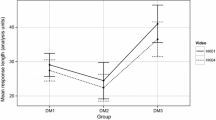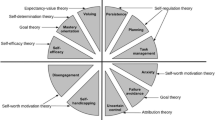Abstract
Mathematics classroom interaction has often been described as an important context for involving all students. However, this article shows that teacher-student-interaction is still not really in the focus of teachers’ attention. Based on classroom video studies, some authors hypothesize that the implicitness of establishing norms and practices is, among others, an obstacle for students with low socio-economic status. The article intends to put this hypothesis into perspective by investigating teachers’ and students’ focus of attention on classroom interaction in video-stimulated group discussions (six discussions with 5–6 students, four discussions with 5–9 teachers). The data analysis used inductive procedures of category development, frequency analysis, and deeper qualitative analysis of the transcripts. For students’ focus of attention, differential patterns could be extrapolated: Whereas students of high socio-economic status seem to be more attentive to teacher’s contextual expectations, the students of low socio-economic status seem to be more focused on general norms without taking into account contextual expectations. For the teachers, the analysis shows that interactive mechanisms of teacher-student exchanges in classrooms are usually not in the teachers’ focus of attention. Additionally, the teachers address, but rarely problematize the implicitness by which norms and practices are established. Together with the differential findings on students’ attention, these findings are discussed with respect to equity concerns and consequences for professional development of teachers.


Similar content being viewed by others
Notes
According to the adopted guidelines for transcribing and translating transcripts, all specialities of the spoken language (mistakes, grammar etc.) are mentioned in the translation. Emphasis is marked by upper case letters. Breaks are coded by a dot for every second in round brackets.
References
Bauersfeld, H. (1983). Subjektive Erfahrungsbereiche als Grundlage einer Interaktionstheorie des Mathematiklernens und -lehrens. In H. Bauersfeld & u.a. (Hrsg.), Lernen und Lehren von Mathematik. Köln: Aulis.
Bernstein, B. (2000). Pedagogy, symbolic control and identity. Theory, research, critique, 2nd edn. Lanham: Rowman & Littlefield.
Bishop, A. (2002). Mathematical acculturation, cultural conflicts, and transition. In G. de Abreu, A. J. Bishop, & N. Presmeg (Eds.), Transitions between contexts of mathematical practices (pp. 193–202). Dordrecht: Kluwer.
Boaler, J. (2002). Learning from teaching: Exploring the relationship between reform curriculum and equity. Journal for Research in Mathematics Education, 33(4), 239–258.
Bohnsack, R. (2009). The interpretation of pictures and the documentary method. Historical Social Research-Historische Sozialforschung, 34(2), 296–321.
Bourne, J. (2003). Vertical discourse: The role of the teacher in the transmission and acquisition of decontextualised language. European Educational Research Journal, 2(4), 496–521.
Carpenter, T., Fennema, E., Peterson & Carey, D. (1988). Teachers’ pedagogical content knowledge of Student’s problem solving in elementary arithmetic. Journal for Research in Mathematics Education, 19, 385–401.
Cobb, P., & Bauersfeld, H. (Eds.). (1995). The emergence of mathematical meaning: Interaction in classroom cultures. Hillsdale: Lawrence Erlbaum.
Cobb, P., & Yackel, E. (1998). A constructivist perspective on the culture of the mathematics classroom. In F. Seeger, J. Voigt, & U. Waschescio (Eds.), The culture of the mathematics classroom. Cambridge: Cambridge University Press.
DIME - Diversity in Mathematics Education Center for Learning and Teaching. (2007). Culture, race, power in mathematics education. In F. Lester (Ed.), Second handbook of research on mathematics teaching and learning (pp. 405–433). Charlotte: Information Age.
Empson, S. B., & Jacobs, V. J. (2008). Learning to listen to Children’s mathematics. In T. Wood & P. Sullivan (Eds.), International handbook of mathematics teacher education (vol. 1, pp. 257–281). Rotterdam: Sense.
Gellert, U., & Hümmer, A.-M. (2008). Soziale Konstruktion von Leistung im Unterricht. Zeitschrift für Erziehungswissenschaft, 11(2), 288–311.
Greeno, J. G., & Gresalfi, M. S. (2008). Opportunities to learn in practice and identity. In P. A. Moss, D. C. Pullin, J. P. Gee, E. H. Haertel, & L. J. Young (Eds.), Assessment, equity, and opportunity to learn (pp. 170–199). New York: Cambridge University Press.
Herbel-Eisenmann, B., Choppin, J., Wagner, D., & Pimm, D. (Eds.). (2012). Equity in discourse for mathematics education. Dordrecht: Springer.
Hunter, J. (2016). Developing interactive mathematical talk: investigating student perceptions and accounts of mathematical reasoning in a changing classroom context. Cambridge Journal of Education, 7(1), 1–18.
Jablonka, E. (2003). The structure of mathematics lessons in German classrooms: Variations on a theme. Paper presented as part of the SIG-Symposium "Mathematics Lessons in Germany, Japan, the USA and Australia: Structure in Diversity and Diversity in Structure" at the Annual Meeting of the American Educational Research Association, Chicago, 21–25 April 2003.
Jorgensen, R. (2010). Structured failing: Reshaping a mathematical future for marginalised learners. In L. Sparrow, B. Kissane, & C. Hurst (Eds.) (2010). Shaping the future of mathematics education. In proceedings of the 33rd annual conference of the mathematics education research Group of Australasia (pp. 26-35). Fremantle: MERGA.
Jungwirth, H., Steinbring, H., Voigt, J., & Wollring, B. (2001). Interpretative classroom research in teacher education. In H. G. Weigand, A. Peter-Koop, N. Neill, K. Reiss, G. Törner, & B. Wollring (Eds.), Developments in mathematics education in Germany (pp. 46–56). Hildesheim: Franzbecker.
Krummheuer, G. (2011). Representation of the notion “learning-as-participation” in everyday situations of mathematics classes. ZDM, 43(1/2), 81–90.
Marshman, M., Geiger, V., & Bennison, A. (Eds.). (2015). Mathematics education in the margins. In proceedings of the 38th annual conference of the mathematics education research Group of Australasia. Sunshine Coast: MERGA.
Mayring, P. (2015). Qualitative content analysis. Theoretical background and procedures. In A. Bikner-Ahsbahs, C. Knipping, & N. Presmeg (Eds.), Approaches to qualitative research in mathematics education (pp. 365–380). Dordrecht: Springer.
Mehan, H. (1979). Learning lessons. Cambridge: Harvard University Press.
Morais, A. M. (2002). Basil Bernstein at the micro level of the classroom. British Journal of Sociology of Education, 23, 559–569.
Morgan, C., Tsatsaroni, A., & Lerman, S. (2002). Mathematics teachers’ positions and practice in discourses of assessment. British Jornal of Sociology of Education, 23, 445–461.
Prediger, S., & Erath, K. (2014). Content or interaction, or both? Synthesizing two German traditions in a video study on learning to explain in mathematics classroom microcultures. Eurasia Journal of Mathematics, Science & Technology Education, 10(4), 313–327.
Heller, V. & Morek, M. (2015). Academic discourse as situated practice: An introduction. Linguistics & Education, 31, 174–184.
Vogler, A.-M., & Prediger, S. (2017). Including students’ diverse perspectives on classroom interactions into video-based professional development for teachers. Journal of Mathematics Teacher Education, 20(5), 497–513. https://doi.org/10.1007/s10857-017-9382-2.
O’Connor, M. C., & Michaels, S. (1993). Aligning academic task and participation status through Revoicing: Analysis of a classroom discourse strategy. Anthropology & Education Quarterly, 24(4), 318–335.
Perry, B., Dawe, L., Howard, P., & Dengate, B. (2000). An investigation of literacy and learning of mathematics in secondary schools serving low socio-economic communities. In J. M. Bana & A. Chapman (Eds.), Mathematics education beyond 2000 proceedings of the 23rd annual conference of the mathematics education research Group of Australasia, Fremantle (pp. 495–502). Fremantle: MERGA.
Schoenfeld, A. H. (2011). Noticing matters. A lot. Now what? In M. G. Sherin, V. R. Jacobs, & R. A. Philipp (Eds.), Mathematics teacher noticing: Seeing through teachers’ eyes (pp. 223–238). New York: Routledge.
Schütte, M., & Kaiser, G. (2011). Equity and the quality of the language used in mathematics education. In B. Atweh, M. Graven, W. Secada, & P. Valero (Eds.), Mapping equity and quality in mathematics education (pp. 237–251). Dordrecht: Springer.
Sertl, M., & Leufer, N. (2012). Bernsteins Theorie der pädagogischen Codes und des pädagogischen Diskurses. Eine Zusammenschau. In M. Sertl & U. Gellert (Eds.), Zur Soziologie des Unterrichts. Arbeiten mit Basil Bernsteins Theorie des pädagogischen Diskurses (pp. 15–62). Beltz Juventa: Weinheim.
Sfard, A. (2008). Thinking as communicating. Human development, the growth of discourses, and mathematizing. Cambridge: Cambridge University Press.
Sherin, M. G. (2007). The development of Teachers’ professional vision in video clubs. In R. Goldman, R. Pea, B. Barron, & S. J. Derry (Eds.), Video research in the learning sciences (pp. 383–395). Mahwah: Lawrence Erlbaum.
Sherin, M. G., Jacobs, V. R., & Philipp, R. A. (Eds.). (2011). Mathematics teacher noticing: Seeing through teachers’ eyes. New York: Routledge.
Skilling, K., Bobis, J., Martin, A. J., Anderson, J., & Way, J. (2016). What secondary teachers think and do about student engagement in mathematics. Mathematics Education Research Journal, 28(4), 545–566. https://doi.org/10.1007/s13394-016-0179-x.
Straehler-Pohl, H., Fernández, S., Gellert, U., & Figueiras, L. (2014). School mathematics registers in a context of low academic expectations. Educational Studies in Mathematics, 85, 175–199.
Tait-McCutcheon, S. L., & Loveridge, J. (2016). Examining equity of opportunities for learning mathematics through positioning theory. Mathematics Education Research Journal, 28(2), 327–348.
Voigt, J. (1995). Thematic patterns of interaction and sociomathematical norms. In P. Cobb & H. Bauersfeld (Eds.), The emergence of mathematical meaning: Interaction in classroom cultures (pp. 163–201). Hillsdale: Lawrence Erlbaum.
Acknowledgements
The research project InterPass — Interactive procedures of establishing matches and divergences for linguistic and microcultural practices — was funded by the German ministry BMBF 2012-2016 (grant 01JC1112, grant holder S. Prediger & U. Quasthoff). We thank our project partner Kirstin Erath for the collaboration in the classroom study. We also thank the involved teachers and students for their participation.
Author information
Authors and Affiliations
Corresponding author
Rights and permissions
About this article
Cite this article
Vogler, AM., Prediger, S., Quasthoff, U. et al. Students’ and teachers’ focus of attention in classroom interaction — subtle sources for the reproduction of social disparities. Math Ed Res J 30, 299–323 (2018). https://doi.org/10.1007/s13394-017-0234-2
Received:
Revised:
Accepted:
Published:
Issue Date:
DOI: https://doi.org/10.1007/s13394-017-0234-2




